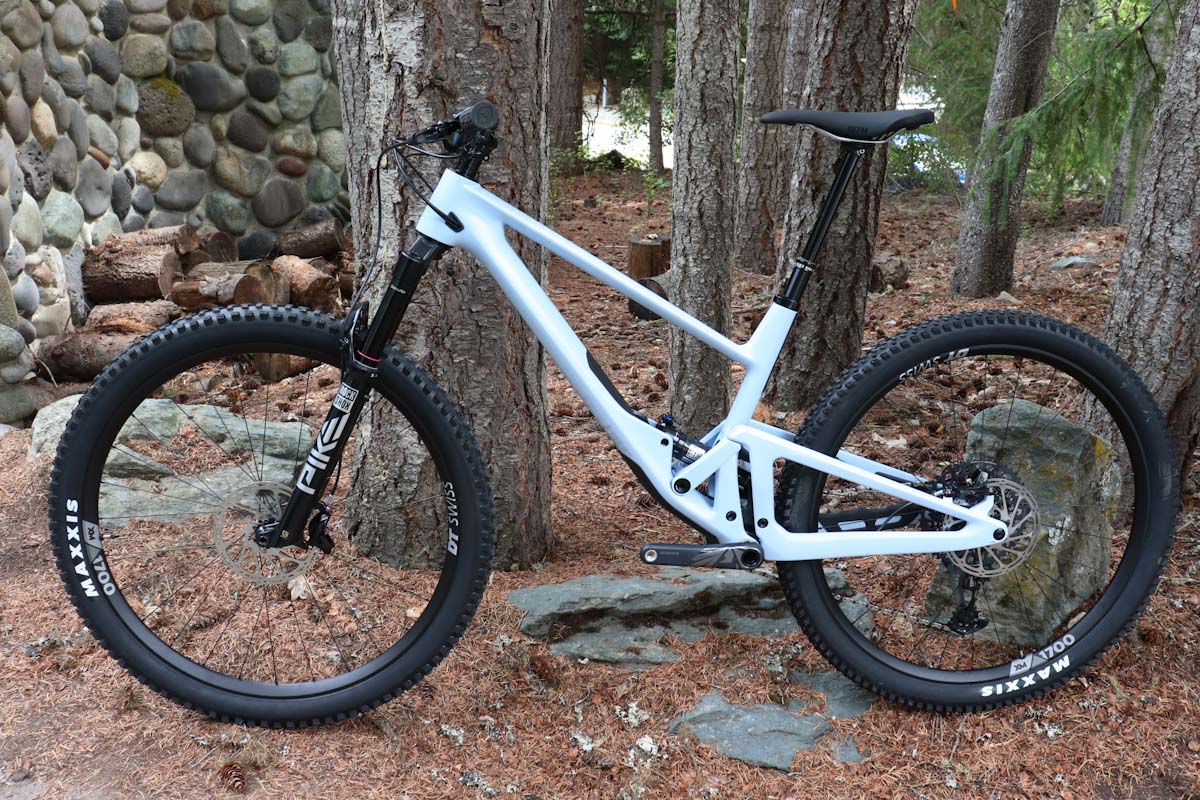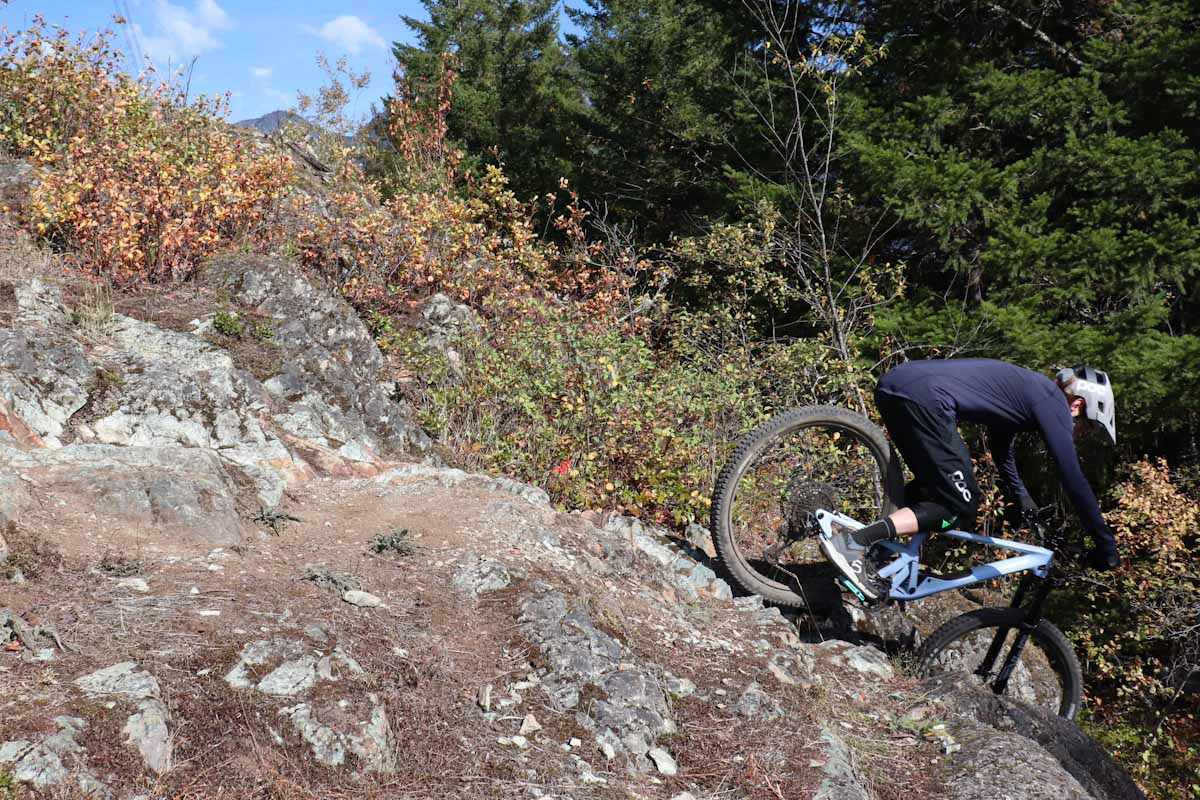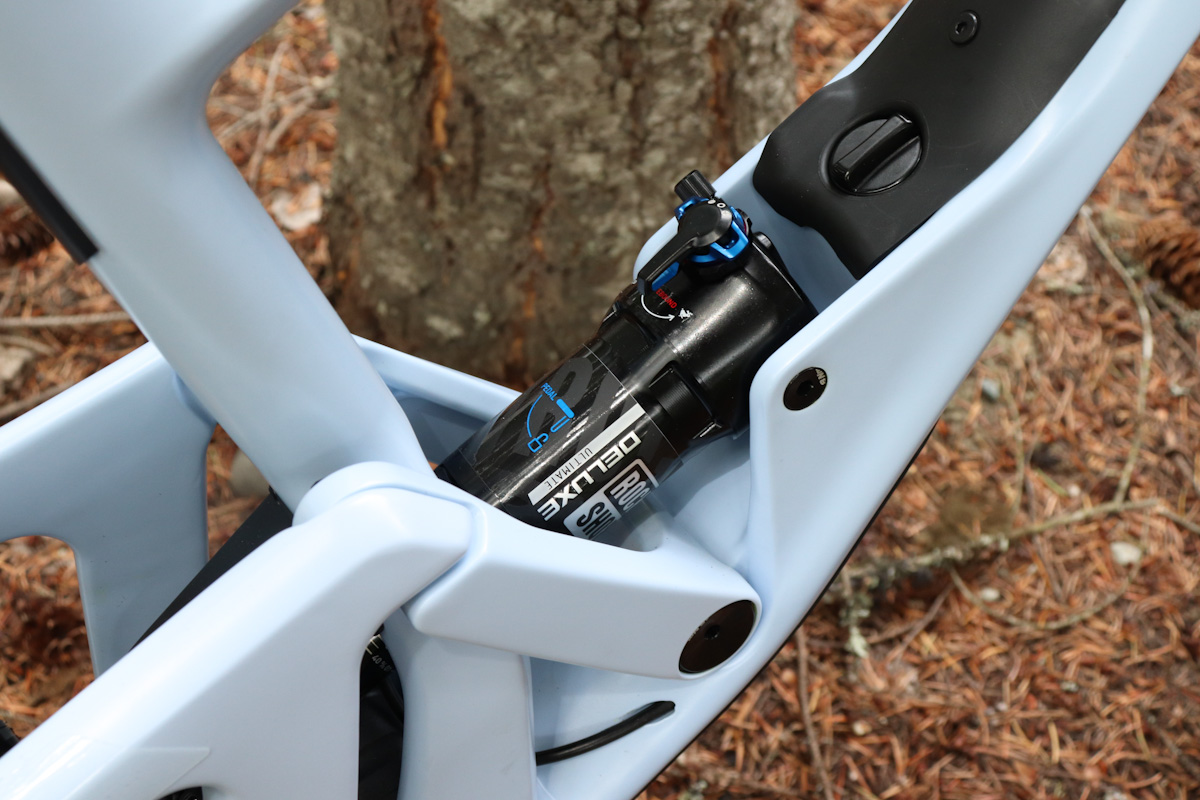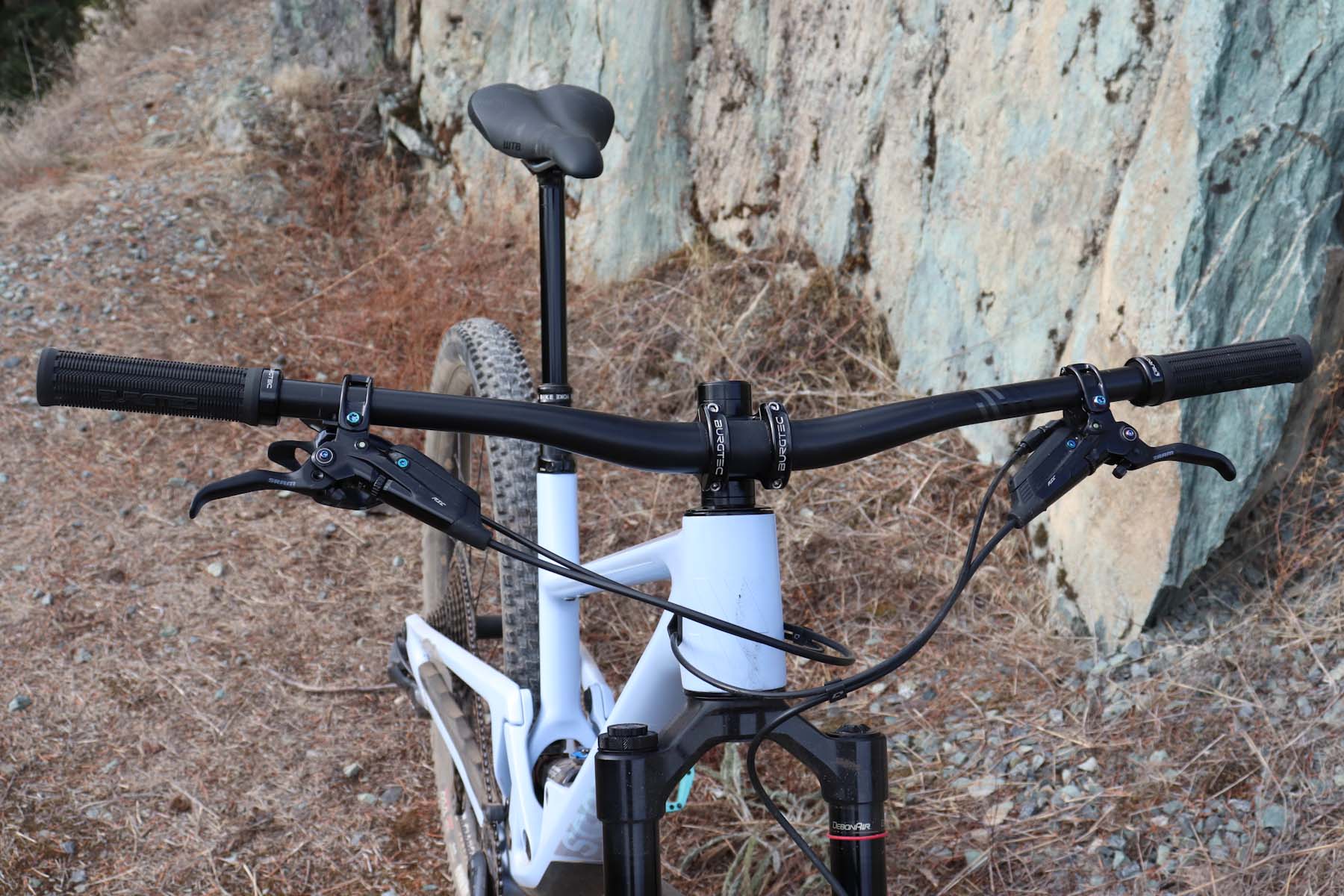By giving the 2030 a very slack head tube, SCOR has created a bike that’s highly capable on rough terrain, while still offering the typical benefits of a shorter travel bike. The 2030 is impressively lightweight, climbs aggressively, and offers a lively, poppy ride.
I usually ride longer travel bikes, but had a blast testing the 2030’s limits on my local trails. There’s no doubt the 120mm rear end requires some help from your arms and legs on the rough stuff. But, I’d stop short of saying this bike begs for finesse or smoother line choices. I didn’t hesitate to ride my area’s roughest, steepest trails on the 2030 and only the chunkiest descents reminded me of the bike’s limited travel.
SCOR 2030 – Key Specs:

For complete details on the 2024 SCOR 2030, link to my launch and first ride article from Crankworx Whistler earlier this summer. Here’s a quick rundown of its key attributes…
The 2030 is a short travel trail bike that’s meant to be shredded hard. It offers 120mm rear travel and comes with a 140mm fork. Frames are available in full carbon only, and all models roll on 29” wheels. To ensure the 2030 can handle rough terrain, SCOR made the frame just as strong as their 4060 enduro bike. They also gave the 2030 a very slack 64.5° head tube angle, 4-piston brakes, wide handlebars and stubby stems.
Geometry/Fit:


At 5’10”, I rode the M/L 2030. At 477mms, this bike has the longest reach I’ve ever ridden, but I did find it comfortable. My arms are nearly straightened out with the seat at full height, so I don’t think I could ride anything much longer, but on the trails the length didn’t feel excessive. I found the long reach (and low stack height) leaned me into a fairly aggressive riding position, which was great for climbing. Standing up on descents, my weight was nicely centered over the bike.

SCOR kept the 2030’s rear ends quite short, at 429mms on the M/L frame. This was done to maintain quick cornering and playfulness despite the bike’s long wheelbase. I will say the longer rear ends I’ve ridden give bikes a great boost in stability, but the 2030 has enough overall length to feel solid on high-speed downhills. While it’s not as agile as the 27.5” Yeti SB135 I recently tested, the 2030 whips around corners and wheelies through whoops nicely. Furthering stability, the 2030 also has a pretty low BB height. Standover height is also fairly low, but not significantly lower than the other bikes in my shed.
Climbing:

SCOR really wants people to see this bike as a highly thrashable ride, but I simply must emphasize how well this thing climbs too. And how could it not, weighing in at 30.78lbs with pedals! With other bikes in my shed topping 35lbs, climbing the 2030 was a joyful privilege! The bike is light enough that it rockets forward with any spirited effort at the pedals. Also, lifting the front or rear end up over an uphill obstacle is an easy task.

Aside from the weight, the 2030 also has a few other aspects that make it a great climber. Geometry wise, the long front end leans you over the bike aggressively, and keeps you centered between the wheels ensuring solid traction. The steep seat tube leaves you in a great pedalling position too. The slack head tube does not leave the bike feeling clumsy on tight switchbacks or hamper its climbing prowess.
Of course you can’t beat the rolling momentum of 29” wheels. And those fast-rolling Maxxis Dissector/Rekon tires stocked on the 2030 do their part as well.

SCOR’s lower-link driven instant centerlinkage doesn’t wallow deep under pedalling efforts or low-speed compressions while climbing. I usually use pedal switches on most bikes, but the 2030 climbs very well with the shock left wide open. With the pedal switch on, the ride was quite firm and I was only dipping about 5-10% beyond the sag point on smoother climbs. Even a highly technical ascent would only provoke about 40% travel out of the rear shock.
I never felt any concerning lack of traction in pedal mode, but on rougher climbs I felt more planted with the shock wide open. After several rides I took a few psi out of the rear shock, and even then the rear end only dove a few mm’s deeper while climbing. In open mode, the most travel I got out of the shock on the bumpiest climbs was about 60%.
Descending:

Without a doubt, that 64.5° head tube is the 2030’s magic trick! I didn’t hesitate to charge this bike down steep terrain that would easily justify a longer travel bike. In terms of handling the 2030 rides just like an enduro, but with less squish to suck up hard hits.
On one ride down a very rough and fast descent, I was reminded of the bike’s short travel when I bounced a foot off my pedal after a big impact. However, that was the only time I had any issue with handling this bike. While a little more body language is required, I was impressed with how fun the 2030 was on gnarly terrain.

The 2030’s suspension is highly progressive so it can handle plenty of hard shredding. On my first few rides I was struggling to bottom the bike out, but after dropping the shock pressure slightly (from 25% to 30% sag) I did get every millimeter out of this bike. The progressive linkage keeps me to about 80-90% travel on mellower rides, and it takes hard hits to eat up all 120mms of the bike’s squish. Again, I’m a lightweight guy but I never felt like I was abusing the 2030… I was just realizing its potential!
I also found the 2030 to offer great mid-stroke support. The progressive tune keeps the bike from riding deep in its travel, so the 2030 can corner hard without wallowing and pop out of berms nicely. It’s also a great jumper, thanks to the supportive suspension and the bike’s low weight.

The 2030’s frame was designed to be very strong, but also offer some lateral flex in the rear end. Pounding through rock gardens the bike does feel a bit softer than your typical enduro… I have the new Trek Slash right now too, and it’s way stiffer overall. For me at 145lbs, I didn’t feel this flex was excessive. It was just enough to allow the rear end to squirm through rocks or roots and maintain as much traction as possible. Adding to its ‘mini enduro’ character, the 2030’s lengthy wheelbase is noticeable as the bike remains pretty stable at high speeds. Another thing that makes this bike a great descender is the M/L size’s 185mm dropper post. With the seat down, it gets very low so you can tuck into steep chutes or slabs easily.
Frame Storage:

I like SCOR’s waterproof ‘Stash Hatch’ storage bag, but what it doesn’t do is cushion what’s inside it. I had a multi tool sitting at the top end of the bag, and I could hear it shaking around inside the down tube while I rode. This may not be a problem if you keep heavier objects at the bottom of the bag.

I had no issue fitting a large c02 canister, inflator head, tire levers, and multi tool in the bag. However, a spare tube had to be strapped to the frame. With what I packed inside the bag, it took some fiddling to get it out of the frame.
Components:

I’ve recently been riding SRAM’s AXS and T-Type electronic drivetrains, but went back to a good ol’ cable driven GX drivetrain on the 2030. I am pleased to say how not disappointed I was! The GX components performed almost perfectly well, only allowing a few hesitant shifts throughout all my rides. SCOR gave the 2030 GX a lightweight carbon crankset, and a compact upper chain guide.

The 2030 GX’s RockShox Deluxe Ultimate RCT rear shock offers a three-position open mode adjustment. This extra switch slightly increases or decreases low speed compression. I mostly rode the shock in its neutral open mode, but did a test run to try the other settings. After riding two similar sections of a rough trail, I can confirm the ‘minus’ setting definitely softens impacts better and allows the shock to dive deeper. The ‘plus’ setting resists impacts more, and produces a slightly rougher ride.

The Pike Ultimate RC2 fork proved fully ample in terms of stiffness. It doesn’t truck through rough stuff like a bigger fork would, but it’s a suitable partner for the 2030’s compliant rear end.

SRAM’s Code RSC brakes were great, even with 180mm rotors they have tons of power to stop this lightweight bike. Also, the oil-slick hardware on the brakes is a nice looking finishing touch! I liked the 800mm wide SCOR carbon bar/Burgtec 35mm stem combo, as it gives the bike enduro-like handling that suits its character.
The BikeYoke Divine 185mm dropper post performed without fault, and again I loved how low the seat gets when dropped. Finally, SCOR gave this bike a WTB Silverado saddle, which I’ve always found pretty comfortable.

While they don’t match the grip of something more luggy, the Maxxis Dissector and Rekon tires were pretty good traction-wise on rock slabs and in dusty conditions. DT Swiss XM 1700 Spline rims held up great, only showing a minor wide-to-side wobble in the rear rim. The 2030’s rims and tires are tubeless ready, but the bike comes with tubes.

The SCOR 2030 GX retails for $7299 (UPDATE – SCOR has dropped the price of this model to $6499). It comes in one ‘Ice Baby’ color.

